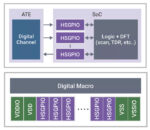On July 9, 2025, Vikram Bhatia, head of product management for Synopsys’ cloud platform, and Sashi Obilisetty, his R&D engineering counterpart, presented a DACtv session on Synopsys FlexEDA, as seen in the YouTube video. Drawing from three and a half years of data, the session showcased how this cloud-based, pay-per-use… Read More
cHBM for AI: Capabilities, Challenges, and Opportunities
AI’s exponential growth is transforming semiconductor design—and memory is now as critical as compute. Multi-die architecture has emerged as the new frontier, and custom High Bandwidth Memory (cHBM) is fast becoming a cornerstone in this evolution. In a panel session at the Synopsys Executive Forum, leaders from AWS, Marvell,… Read More
Podcast EP299: The Current and Future Capabilities of Static Verification at Synopsys with Rimpy Chugh
Dan is joined by Rimpy Chugh, a Principal Product Manager at Synopsys with 14 years of varied experience in EDA and functional verification. Prior to joining Synopsys, Rimpy held field applications and verification engineering positions at Mentor Graphics, Cadence and HCL Technologies.
Dan explores the expanding role of static… Read More
Synopsys Addresses the Test Barrier for Heterogeneous Integration
The trend is clear, AI and HPC is moving to chiplet-based, or heterogenous design to achieve the highest levels of performance, while traditional monolithic system-on-chip (SoC) designs struggle to scale. What is also clear is the road to this new design style is not a smooth one. There are many challenges to overcome. Some are … Read More
Design-Technology Co-Optimization (DTCO) Accelerates Market Readiness of Angstrom-Scale Process Technologies
Design-Technology Co-Optimization (DTCO) has been a foundational concept in semiconductor engineering for years. So, when Synopsys referenced DTCO in their April 2025 press release about enabling Angstrom-scale chip designs on Intel’s 18A and 18A-P process technologies, it may have sounded familiar—almost expected. … Read More
WEBINAR: PCIe 7.0? Understanding Why Now Is the Time to Transition
PCIe is familiar to legions of PC users as a high-performance enabler for expansion slots, especially GPU-based graphics cards and M.2 SSDs. It connects higher-bandwidth networking adapters and niche applications like system expansion chassis in server environments. Each PCIe specification generation has provided a leap… Read More
The Road to Innovation with Synopsys 224G PHY IP From Silicon to Scale: Synopsys 224G PHY Enables Next Gen Scaling Networks
The explosive growth of large language models (LLMs) has created substantial new requirements for chip-to-chip interconnects. These very large models are trained in high-performance data centers. Multiple accelerators need to work seamlessly to make all this possible as the bandwidth between accelerators directly impacts… Read More
Webinar – Achieving Seamless 1.6 Tbps Interoperability with Samtec and Synopsys
It is well-known that AI is upending conventional wisdom for system design. Workload-specific processor configurations are growing at an exponential rate. Along with this is an exponential growth in data bandwidth needs, creating an urgency for 1.6T Ethernet. A recent SemiWiki webinar dove into these issues. Synopsys and … Read More
SNUG 2025: A Watershed Moment for EDA – Part 2
At this year’s SNUG (Synopsys Users Group) conference, Richard Ho, Head of Hardware, OpenAI, delivered the second keynote, titled “Scaling Compute for the Age of Intelligence.” In his presentation, Richard guided the audience through the transformative trends and implications of the intelligence era now unfolding before… Read More
Automotive Functional Safety (FuSa) Challenges
Modern vehicles have become quite sophisticated, like a supercomputer on wheels. They integrate a vast number of electronic components, including thousands of chips, to deliver advanced functionalities ranging from infotainment to critical safety systems. This increasing complexity necessitates a robust approach to … Read More









